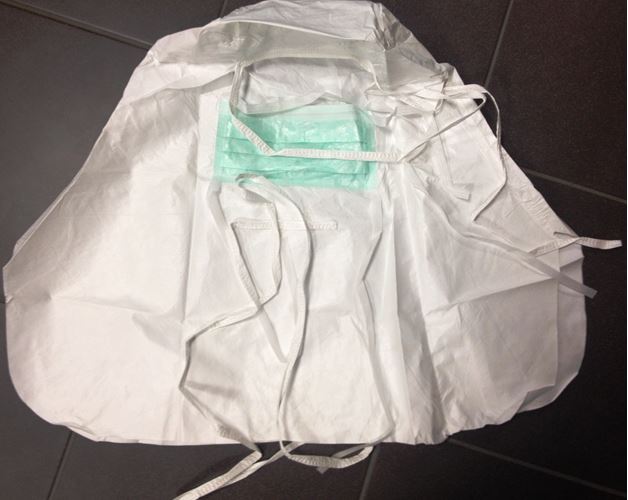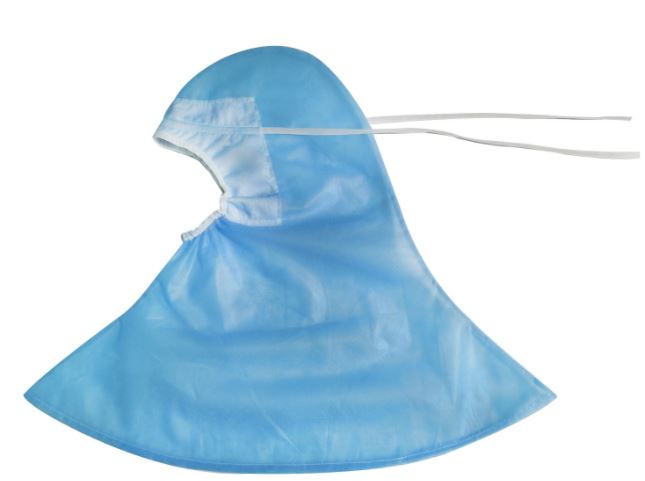HOOD, non-woven, integrated mask, VHF, s.u
Valid Article
HOOD, non-woven, VHF, s.u.
Definition
A non-sterile head covering designed as a top with elongated sides and back with a front opening for the face to be used by all staff members working in VHF contexts to cover their hair and facial hair (beards) in order to protect both the patient and themselves from the transfer of microorganisms, body fluids, and particulate material.
Synonym
head gear
Specifications
Quality standards
Quality Standards Comment
PPE Category III
EN 14126 comprises the following material tests:
- ISO 16603: 2004 (confirmed 2014): Clothing for protection against contact with blood and body fluids -- Determination of the resistance of protective clothing materials to penetration by blood and body fluids -- Test method using synthetic blood
- ISO 16604: 2004 (confirmed 2014): Clothing for protection against contact with blood and body fluids -- Determination of resistance of protective clothing materials to penetration by blood-borne pathogens -- Test method using Phi-X 174 bacteriophage
- ISO 22610: 2018: Surgical drapes, gowns and clean air suits, used as medical devices, for patients, clinical staff and equipment - Test method to determine the resistance to wet bacterial penetration
- ISO 22612: 2005: Clothing for protection against infectious agents - Test method for resistance to dry microbial penetration (confirmed in 2020)
Technical specifications
- Fabric: ≥4/6 for test ISO 16603 and ≥4/6 for test ISO 16604
- Puntiform
- Tyvek: a spunbonded nonwoven material made from high-density polyethylene fibers. It can resist repeated folding and flexing without tearing. It can also be glued, laminated, sewn, stapled and fixed.
- Seems :
- sewed and covered (=sealed) or welded with ultrasounds
- Form/design :
- Covers the head, the neck, and the shoulders
- Non-elastic opening for the face
- Surgical mask IIR integrated enabling to cover 100% of the face except the eyes and surroundings
- 3 pairs of straps to tighten for fixation behind the head
- 1 or 2 pairs of straps for fixation at the height of the torso
- Universal size
- Non sterile, for single use
- Unit presentation
Instructions for use
Wearing the hood is mandatory:
- For medical and non-medical staff working in the high-risk zone of a VHF treatment unit
- For burial team in charge of preparation, transport and burial of corpses of people died of VHF and when carrying out disinfection of the morgue
- For ambulance team when transporting patients of VHF and carrying out disinfection of the ambulance
- For mobile team in charge of house disinfection
- For waste management staff when handling or disposing of VHF contaminated waste
- For all persons (staff and patients' attendants) in close contact with a patient with suspected or known VHF or SARS. Not suitable for family and visitors
MSF requirements
The hood is part of the full personal protective equipment worn in VHF contexts: see the protective equipment module of the VHF kit.
Indispensable item for the protection of staff and patients' attendants against blood-borne pathogens in haemorrhagic fever contexts.






![[KMEDMEBO13A] (module VHF) MODULE ENVIRONMENTAL HEALTH](/web/image/product.template/571761/image_256/%5BKMEDMEBO13A%5D%20%28module%20VHF%29%20MODULE%20ENVIRONMENTAL%20HEALTH?unique=72f3843)
![[KMEDMEBO03-] (module VHF isolation) PROTECTIVE EQUIPMENT](/web/image/product.template/571782/image_256/%5BKMEDMEBO03-%5D%20%28module%20VHF%20isolation%29%20PROTECTIVE%20EQUIPMENT?unique=77cac43)
![[KMEDMEBO11-] (module VHF) TRAINING MODULE](/web/image/product.template/571738/image_256/%5BKMEDMEBO11-%5D%20%28module%20VHF%29%20TRAINING%20MODULE?unique=e000fd4)
![[KMEDMEBO17A] (module VHF) SAMPLING AND SMALL ISOLATION](/web/image/product.template/571758/image_256/%5BKMEDMEBO17A%5D%20%28module%20VHF%29%20SAMPLING%20AND%20SMALL%20ISOLATION?unique=e000fd4)
![[SPPECOVPT2L] COVERALL, no hood, L (Tychem QC 125T)](/web/image/product.template/571662/image_256/%5BSPPECOVPT2L%5D%20COVERALL%2C%20no%20hood%2C%20L%20%28Tychem%20QC%20125T%29?unique=a8b8644)
![[SPPECOVPT2M] COVERALL, no hood, M (Tychem QC 125T)](/web/image/product.template/571591/image_256/%5BSPPECOVPT2M%5D%20COVERALL%2C%20no%20hood%2C%20M%20%28Tychem%20QC%20125T%29?unique=b7c1b7e)
![[SPPECOVPT2XL] COVERALL, no hood, XL (Tychem QC 125T)](/web/image/product.template/571333/image_256/%5BSPPECOVPT2XL%5D%20COVERALL%2C%20no%20hood%2C%20XL%20%28Tychem%20QC%20125T%29?unique=2703dc8)
![[SPPECOVPT2XXL] COVERALL, no hood, XXL (Tychem QC 125T)](/web/image/product.template/569433/image_256/%5BSPPECOVPT2XXL%5D%20COVERALL%2C%20no%20hood%2C%20XXL%20%28Tychem%20QC%20125T%29?unique=051176f)